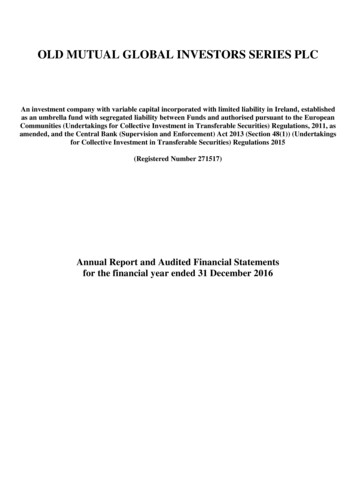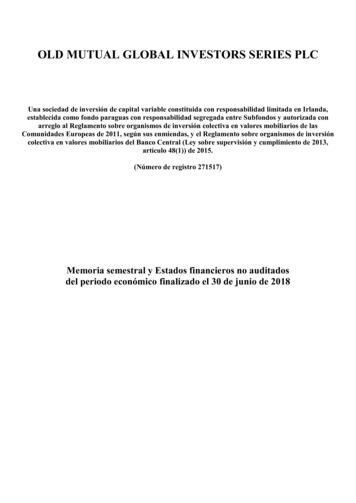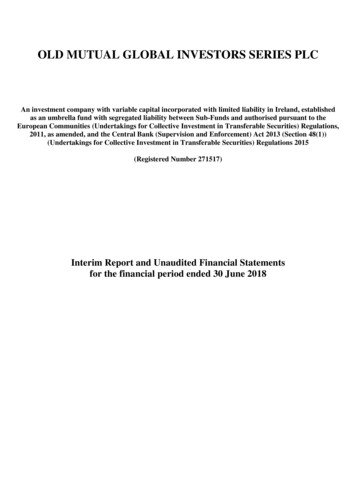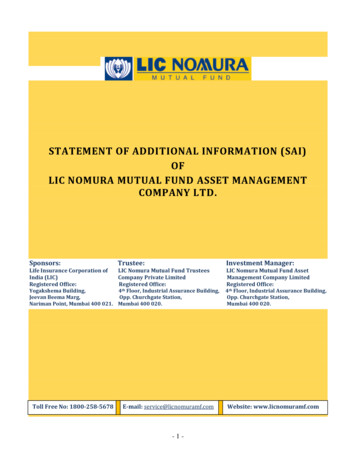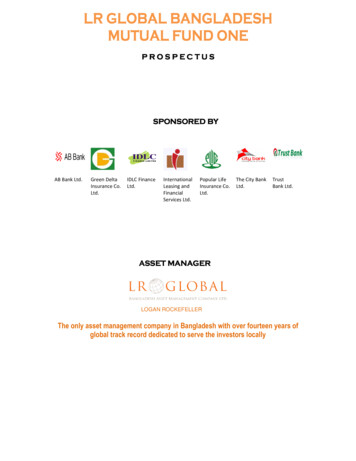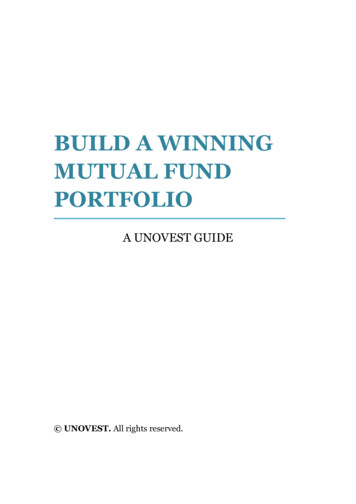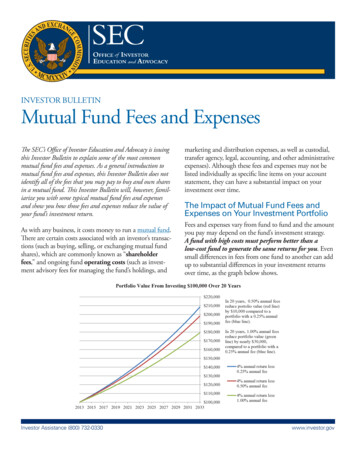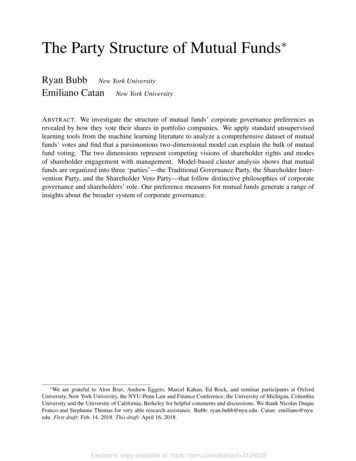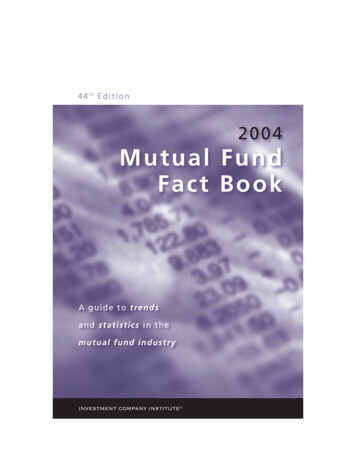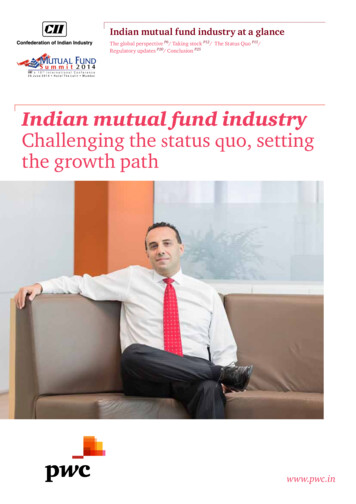
Transcription
Indian mutual fund industry at a glanceThe global perspective P6/ Taking stock P12/ The Status Quo P15/Regulatory updates P20/ Conclusion P25Indian mutual fund industryChallenging the status quo, settingthe growth pathwww.pwc.in
Chairman’s messageThe mutual fund industry spanning almost two decades now has seen its share of success and failure. It is quitecommendable that we have reached a mark of almost 10 trillion INR of assets under management as of May 2014.This has been a result of collaboration of all industry stakeholders like the distributor, the asset managementcompany and the regulator who has shaped the way forward for the industry.Having said that, participation from metros too remains low if we go by the number of investors and increase inwallet share. There is also a concern of having investors stay invested in mutual funds and perceive the long-termbenefits of the product. Investors need to realise that mutual funds is a way to meet their financial goals and notjust a means of short-term financial gain. Given the current scenario of market volatility and uncertainty, theinvestor perceives investments in the capital market to be risky and unsafe, and hesitates to channelise his savingsinto mutual fund products. Fund managers need to instil that confidence in the minds of investors and encouragethem to stay invested in funds to derive the desired benefits.The decade edition of the Mutual Fund Summit looks to assess how the mutual fund industry has evolved andtransformed over the years, maturing with every development that is taking place. It also places focusses on thegaps and issues that remained to be addressed in terms of the product, the distribution and the investor.This report by CII - PwC titled ‘Indian mutual fund industry: Challenging the status quo, setting the growth path’discusses how the industry can challenge itself and draw perspectives from other markets and industries to reachthe next level of growth.We hope you find this report insightful and useful. We welcome your comments or suggestions.A BalasubramanianChairman, CII Mutual Fund Summit 2014Chief Executive Officer, Birla Sun Life Asset Management Co Ltd
ForewordAs we celebrate the completion of a decade of the CII Mutual Fund Summit, it givesus immense pleasure to be a part of this journey with CII and share our thoughts andperspectives by way of this background paper, and especially at a time when India ispoised at an interesting and exciting juncture, with hopes of seeing a sustainedgood run.This year, the paper titled “Challenging the status quo, setting the growth path”, on theone hand, takes a look out globally and into the future, and on the other, takes a lookinside and into the past. The report showcases a global perspective elaborating on someof the global trends, strategic drivers and cross-border distribution, while highlightingthe game changers in the industry, and does some crystal ball gazing into futureprojections. It also traces the growth of the Indian mutual fund industry in the last twodecades, and assesses how the industry has evolved in terms of schemes, products andcompanies. Compared to the global landscape where the AuM to GDP ratio averages37%, the ratio in India stands at 7 to 8%.The report tries to capture the various areas where status quo exists in terms ofinvestor mix, alternative products and the advisory model and distribution ofproducts. The report also explores some of the solutions on how this status quo can beaddressed with examples of pricing, product positioning and product relevance.The report goes on to encapsulate a few regulatory updates not only from India, butacross global markets including some of the directives like FATCA and fund passport,which are giving a new shape to the mutual fund industry.We hope you find this report a considerable value add and welcome any thoughts onimproving this report in the following year.Gautam MehraExecutive Director, PricewaterhouseCoopers Pvt. Ltd.Mobile: 91 9867033822Email: gautam.mehra@in.pwc.com
It has been a little over 20 years since the asset management industry was opened up to the entry of new players. The objectivewas to expand the business by widening and deepening the market for asset management products. The inclusion of assetmanagement products in the basket of traditional investment avenues such as cash-in-hand, corporate and fixed deposits(FDs), savings accounts, stocks and gold was expected to occur over time.The mid-90s saw the emergence of stock investment trends with large-scale retail investments in the primary and secondarystock markets. The IPO boom of the early 90s saw retail investors opting to invest a significant portion of their investiblesurpluses in the stock markets. The enhanced liquidity chasing stocks correspondingly saw a surge in the BSE Sensex fromunder 2000 in 1992 to around 5000 as on 31 March 2000.The same period also saw the asset management industry expand rapidly in terms of number of schemes, products andcompanies. Considering the industry is still relatively young, its evolution and growth over the two decades is impressive.This is true in all aspects and not just about the scale of growth of assets under management (AuM). It applies to the creationof evolved products as well as the human capital and skill development. The ecosystem including support and outsourcedfunctions has been created and knit together almost from scratch.The regulatory regime kept pace with the changing environment and the AuM of the asset management industry grew from470 billion INR in 1993 to 1396 billion INR in 2004 and to 8252 billion INR in 2014.4 PwC
AuM growthIn 000 million 08Mar-10Mar-12Mar-13Mar-14It has been two decades since the regulators set the industry on the path to growth and expansion. Therefore this is perhaps agood time to step back, take a look and assess in order to help chart the course for the next decade.Indian mutual fund industry 5
The globalperspectiveIndustry ecosystemThe global asset management industryfootprint by product and investorThere is rich diversity in the sector as the assetmanagement industry offers a mix of traditionalmutual fund products and alternatives (realestate and hedge funds). The investor universethat the industry taps covers insurance funds,pension funds, sovereign wealth funds (SWFs)and high net worth individuals (HNWIs) /massaffluent/retail investors.In 2012, the global asset management industrymanaged 36.5% of the assets held by pensionfunds, SWFs, insurance companies and HNWIs/mass affluent. This represents a huge pool ofinvestible resources that global industry playersare able to tap into.It is evident that Indian asset managementaddresses only a subset of the investors thatits global counterparts do. The regulatorymandates in place in evolved economies allowaccess to the insurance and pension sectors.The industry structure possibly looks tocreate and harness core competencies in assetmanagement. Industries such as insurance andpensions are allowed to invest in markets viaasset managers with regulated and calibratedexposure levels.The ability to tapinto fund pools withthe insurance andpension segmentswill be key to growth.6 PwC
Global trendsWe believe the trends of products, customers and distribution and operations, to different degrees, will be relevant to mostmajor markets and geographies.ProductCustomer / distributionOperations Alternatives to go mainstream with retailisation ETFs here to stay Retirement products Fund houses seeking global growth opportunities Big data analytics becoming important to identify opportunities and customer needs Continuing transparency and information requirements Multiple drivers for investing in technology Outsourcing being re-examined over concerns about loss of data/control and fiduciaryrequirements Recordkeeping complexitiesGlobal strategic driversStrategic drivers are shaping the business as we speak and will continue to be relevant in the near future. The relativeimportance of one or the other of these will differ from market to market.Customers Life insurance cos experiencing severe challenges totheir business models An increasingly sophisticated and aware customerbase seeking value in their investment providers The changing and lengthening retirement journey Growing propensity around DIY behaviour onlineRegulators InvestorsKey challenges for asset managers Maintaining / growing volumes and revenues Re-positioning cost bases for value growth Balancing sustainable profit and customer outcomes Generating cash and attractive shareholder returns Avoiding regulatory intervention (S166 in the UK) High demand forincome, in the form ofdividendsHigher returns on offerin other/overseasmarkets – shareholdersseeking to extract cash/ capital to redeploy Distributors Distributors moving towards ownership of thecustomer Seeking providers who can help them reduce costs inother ways Rebuilding a new ‘value chain’Regulatory scrutinycontinues around threethemes:––Customer protection(MiFID II, RDR in theUK, FCA, AIFMD)––Fairness forcustomers––Tax (FATCA)Higher cost and focus onevidencing compliancewith pressure onexcessive returnsIndian mutual fund industry 7
Growth trends and expectationsIn 2012, the global aggregate AuM with asset managersstood at 64 trillion USD. This broadly comprised mutualfund assets (27 trillion USD), mandated AuM (i.e. assetallocations from global pension funds, insurance industry,SWFs, etc for the management/advisory services of assetmanagers; 30.4 trillion USD) and alternative investments(6.4 trillion USD).The global aggregate AuM is expected to exceed 100 trillionUSD by 2020! The components of that figure are expected togrow. Significant growth is expected in mandated AuM aswell as alternative investments.AuM in trillion USD120101.7 %1.1%16.3% 25.41.3%28.820042007Mutual 5.7%27.020125.4%41.22020Alternative investmentsThe growth of global investable assets will be driven by fivemain trends: The rise in retirement savings as the aging of theworld’s population continues. The increased weight of the SWF market as new SWFsare formed and assets double. The shift in emerging markets from savings toinvesting cultures. The rise in wealth accumulated by HNWIs and massaffluents. The move by traditional defined benefits in developedmarkets into alternative investments.8 PwC
The South America, Africa, Asia and the Middle East(SAAME) region is expected to see the highest growth ratesover the period to 2020.Alternative and exchange-tradedproducts (ETP)Globally, the alternative assets segment has grown andevolved at a rapid pace and the considered global view is thatalternatives and ETPs will grow at a faster pace in the future.The Indian asset management industry is virtuallysynonymous with mutual funds and exchange traded funds(ETFs) and alternatives are yet to find significant traction inour environment.It might well be truethat domestic fundmanagers haveoutperformed globalfund managers inmanaging investmentinto Indian capitalmarkets.While it is a given that not every asset manager should or willoccupy all segments of the industry, there is an opportunityto widen the offering and to bring on board alternativeproducts relevant to and that leverage the existing skill setsand capabilities of the Indian market.Global alternative assets in trillion USD1413.0 CAGR129.3%AuM in trillion USD10120101.71.56.7 CAGR10016.28087.5% 59.4 8.8%1.610.4%35.9% 6.460402037.30.63.912.919.9018.5% 21.03.6%17.5%-1.2%14.8% 30.12.0%2004North AmericaLatin 0 From 2012 to 2020, the growth rate of global AuM willbe lower in non-SAAAME regions than in SAAAMEregions. This is because the rise in wealth is greater inSAAAME than in non-SAAAME regions. In addition, the market is more mature in non-SAAMEthan in SAAAME regions.2.50.31.11.131.5%24.1%Hedge funds5.1%Asia Pacific32.6%200449.4Middle East and .52.11.414.9%10.5%2.50.0%3.5%2007Private equity9.4%2.54.88.4%20122020Real estate Alternative assets are expected to grow by 9.3% until2020. The growth of alternatives will be driven by existingand emerging HNWIs and SWFs. Despite significant regulation of the sector, thedemand for alternatives will continue to grow.Investors in search of greater alpha will broaden theirexposure to include alternatives, especially in thecurrent low yield environment.Indian mutual fund industry 9
Cross-border distributionThere have been significant moves by Asian and LatinAmerican (LATAM) peers in the area of global funddistribution, with a significant number of cross-borderregistrations. PwC believes that regional blocks will emerge–North Asia, South Asia, LATAM and Europe–across whichproducts will be sold pan-regionally. As these frameworksdevelop, asset managers will need to look again at theirdistribution challenges and strategies as access to and fornew investors becomes a reality.UCITS registration growth in Asia and LATAM (2006 to 2012)KoreaTaiwan328259Hong hAfricaSingapore93204Number of x- border registrations in the end of 2012Number of x- border registrations in 200610 PwC864
Retail distributionThe distribution models continue to evolve and so do theassociated cost/fee structures. This is taking place onaccount of not just downward pressure on costs but also tobetter align distributors and investors.Recently the Financial Services Authority in the UKundertook an exercise to study and recommend changes toretail distribution models and practices. This exercise wascommonly referred to as the Retail Distribution Review.The global perspective: Conclusion Over half of the AuM of the global asset managementindustry is in areas other than traditional mutual funds.Mandated and alternative assets comprise almost 60% ofthe total industry AuM and the latter segment is growingrapidly. The asset management industry is growing to astature comparable to banking and insurance. Investors are showing increasing interest in and demandfor alternative investment assets. Distribution models and the costs involved are constantlybeing re-examined. Distribution is expected to go ‘glocal’. Technology continues to remain critical.We believe the six gamechangers in the asset managementspace to be as follows: Asset management will move centrestage. Distribution will be redrawn such that regional andglobal platforms will be redrawn. Fee models will be transformed. Alternatives will become more mainstream, passives willbecome core and ETFs will proliferate. There will be a new breed of managers. Asset management will enter the 21st century.While the debate about Indian AMCs accessing thedomestic pension corpus will continue, a significantportion of global pension and insurance funds isallocated for investment in Asian capital marketsincluding India. The opportunity to render investmentadvice to such fund managers is immense. Weunderstand that it will not be easy to win such mandatesbut the effort would be worth it. It is estimated that 17 to20% of Indian market capitalisation is held by foreignfunds. However, a remarkably small fraction of thesefunds are advised and managed by Indian assetmanagers.Indian mutual fund industry 11
Taking stock:A view fromthe outsideShare of the investment poolWhile the industry has grown significantly andthere is much to be satisfied about, there areopportunities for improvement too.While the AuM has grown from approximately470 billion INR as on 31 March 1993 toapproximately 8,250 billion INR as on31 March 2014 (reflecting a CAGR of 14.6%over the last 21 years), the Sensex has grownfrom approximately 2280.52 as on 31 March1993 to 22,386.27 as on 31 March 2014(reflecting a CAGR of approximately 11.5%).Quite naturally, the growth of the Sensexand the AuM feed off one another and thus aportion of the AuM growth can be attributed tothe growth of underlying stocks and indices.Perhaps it might be useful to revisit the broadsavings and investment basket to help us reviewindustry progress and growth.The industry has seen net flows ofapproximately 4900 billion INR from 2001to 2014 (an average of 352 billion INR perannum). The change in the financial assets(gross financial savings) of the householdsector in FY2012-13 was approximately109,69 billion INR, of which mutual fundsattracted 274 billion INR (approximately2.5%). Compared to this, the amount held incurrencies was approximately 10%, the amountinvested in deposits approximately 56%,life insurance gathered approximately 16%and pensions and provident funds gatheredapproximately 14.5%. Moreover, change infinancial assets accounted for only a third oftotal household savings, the remaining twothirds held in physical assets such as gold andreal estate. Would it therefore be fair to say thatmutual fund products do not enjoy what might12 PwCbe called a ‘fair’ share of the wallet? Are the mutualfund products competing successfully againstalternatives such as FDs, gold and lately real estate?Mutual fund penetration in India is low ascompared to global and peer benchmarks. The AuMto GDP ratio stands at 7 to 8% as compared to aglobal average of 37%. Even the SAAAME economyof Brazil, considered a peer emerging economy, issignificantly ahead, with an AuM to GDP ratio of45% (Source – AMFI, ICI FactBook 2013).Increasing mutual fund penetration will largelydepend on increasing investor awareness atgrass-roots level and providing access to financialservices to the still largely unbanked population.In its effort to increase investor awareness, theindustry and the Securities and Exchange Boardof India (SEBI) have launched several initiatives.These include literature and campaigns topropagate financial education to various investorsegments (including potential investors), suchas school and college students, homemakers,executives, etc.The two-pronged approach of increasing awarenessof and access to financial products and services hasand will go a long way in increasing the penetrationof mutual funds in the country.While it might be uncharitable to compare this withsimilar data from western economies, importantlessons can be learnt from them as well, whenlooking forward.
Investor mixAuM by geography (2013)The asset management industry held 39.5 million folios ason 31 March 2014, which has declined from around 47.6million as on 31 March 2009. The composition of the sourcesof investment for the industry as a whole in 2009 and in 2014is given here. This shows that the industry has not managedto improve the share of retail and individual investors in theAuM of the industry over the last decade.The charts below depict AuM from three perspectives – by investortype, by geography and by investment type. Typically, corporateshave the lion’s share of the total AuM, which is concentrated in thetop five cities. Most of the investments have been found to be inincome funds followed by equity.6%5%3%Top 5 citiesNext 10 citiesNext 20 cities13%Next 75 citiesOther cities74%AuM by geography (2014)Break up of AuM by investor type (2009)6%51%Corporates5%3%Top 5 citiesNext 10 citiesNext 20 cities13%Next 75 citiesFIIsOther citiesBanks/FIs5%1%21%High net worth individuals*Retail74%22%Break up of AuM by investor type (2014)49%CorporatesFIIsBanks/FIs2%1%High net worth individuals*Retail21%27%In the immediate period since the above, there has notbeen a discernible change in statistical trends as yet. Theindustry AuM from towns other than in the top 15 wasapproximately 871.4 billion INR as on 31 March 2012 andwas approximately 1126.5 billion INR as on31 March 2014 (reflecting a CAGR of approximately13.7%). This translates into 14.84% and 13.65% ofindustry AuM in the respective years.Yet, it is true that there are investible surpluses availablein cities beyond the top 15, at least more than what hasbeen tapped by the asset management industry so far.The share of AuM from the top metros has remainedrelatively high and recently SEBI has amended relevantguidelines to improve the economics of selling to investorsin cities other than the top 15. This was done to revitalisemechanisms for reaching the larger mass investor in Tier 2and 3 towns, not only through distribution economics butby enabling distribution through multiple channels such asretired government employees, etc.Indian mutual fund industry 13
AuM by Investment Type (2014)The amount of data andinformation needed to bepublished by the mutualfund industry is significantlymore than for any otherfinancial product. The utilityvalue of it as perceived by aninvestor needs to beascertained.Income20%16%3%2%1%1%1% 0%0%56%Liquid/ money marketBalancedGiltFund of fund investing overseasEquity (other than ELSS)Equity (ELSS)Gold ETFOther ETFInfrastructure debt fundSales and marketingProduct basketOver the years the industry has developed an extensiveproduct basket covering various investment opportunities.However, the 80-20 rule applies. Over 80% of the AuM is inless than 20% of the product categories. Is there room forsimplification of the product basket?AuM by Investment Type (2013)Income21%13%Liquid/ money marketBalanced3%2%2%1%0% 0%0%56%GiltFund of fund investing overseasEquity (other than ELSS)Equity (ELSS)GoldOther ETFInfrastructure debt fund14 PwCThe industry has been operating on what we know as the‘open architecture’ distribution model, with no tied agents.Although the ability to invest directly now exists, theindustry is largely reliant on the distributor fraternity at thefront end.Over the years, the distribution economics have beenchanged to correct a few anomalies such as churn, etc.However, as things stand, the number of AMFI registrationnumbers (ARNs) has declined from around 82,015 as on 31March 2011 to 58,167 as on 31 December 2013.The industry needs to analyse this trend in all its aspects.Unfortunately, there may not be a ‘one-size-fits-all’ solutionthat will work.
The StatusQuoWhen we take stock along the above lines,several aspects seem to surface. Share of the investment pool: Theindustry has no doubt grown but it is yet totake away significant market share fromother traditional investment products.While all fund houses make concertedefforts at investor education with campsand campaigns, the products of the industryare reaching nowhere near the kind ofprimacy in the investor’s mind.Tax and indexationbenefits are rarelywell communicatedto or understood byinvestors. Investor mix: The investor mix hasremained almost static with non-retailparticipation remaining high and the bulk ofinvestors coming from the top 15 cities. Alternative products and advisory model:While the industry offers a wide variety ofmutual fund products, only a few garner thelion’s share of the AuM. Non-mutual fundproducts and services (alternatives andadvisory) are yet to take off significantly. Distribution: The industry has always workedwithin the ‘given’ of an open architecturedistribution model and while a few efforts havebeen made at exploring additional anddifferent channels of distribution, they havenot significantly augmented the existingdistribution structure.Lowering costs hasnot led to discerniblecorrespondingincreased inflows intomutual funds.As the industry embarks on its third decade,this presents an opportunity to assess andchart new exciting courses by challenging thestatus quo with the objective of catapultingthe industry into the next level of growth andtaking it to the position that it enjoys in otherdeveloped economies.Challenging the Status QuoStatus Quo one: Share of the investmentpoolWhile expandingbeyond the top-15cities is a positive step,it requires theorganisation to beoperationally gearedto do this successfully.This remains a stark issue for the industrydespite tireless efforts by all constituents.The industry still garners less than 3% ofthe incremental investible surplus from thehousehold financial savings pie.As the culture shifts from savings toinvestments, there is an opportunity to gainadditional market share. However, this willrequire appropriate and relevant products,pricing, positioning and sales.Indian mutual fund industry 15
Product relevance: The industry offers a basket ofproducts which at times seem over-crowded andcomplicated, yet the front-line sales function remainsunclear about the right product for each type of investor.A mis-sold product is unlikely to deliver the benefits needed,desired or expected and will probably lead the investor not toreturn. Pricing: With respect to the asset management industrythis refers to the charges and costs associated with theinvestment. In this respect, while there is a tremendousamount of information available from the assetmanagers, most investors are likely to be unaware ofbrokerages incentives, etc.Positioning: In any market product-positioning is acritical aspect; how to position the product in anovercrowded space; in a way that attracts greaterattention as compared to competitors.Traditional alternatives such as FDs and gold have continuedto dominate and recently, real estate investments haveattracted a large portion of the investible surplus. Thechallenge for the asset management industry is to enhancethe visibility and profile of its products in the mind of theinvestor. This means communicating the relevance of theproducts and their benefits.Additional tax exemptionsover and above current taxexemptions for investment inmutual funds will create animmediate ’pull’ demand forproducts and all taxpayerswill become mutual fundclients with almost nilacquisition cost.16 PwCThe development of mobile technology and the emergenceof social media offer individual investors innovative waysto access and scrutinise the investment fund industry.It also presents a new challenge for the fund promoterswho are required to evolve their marketing strategy andaccommodate, leverage these new communication channels.For instance, in the UK, one of the biggest fund distributors isalready proposing an application on iPhone allowing clientsto acquire information regarding fund price, performanceand management fees on a range of more than 1000 funds.Clients will also have the opportunity to invest through thefund platform.It is already possible to very specifically target a desiredaudience set through social media analytics. This enablesmarketing teams to focus their messages toward the desiredtarget audience more specifically and tailor the messagesappropriately.Status Quo two: Investor mixIn many ways investor mix is related to market share. Anycorrection will involve accessing new investors, whichwill go some distance towards tackling the investor mixissue as well. The regulator has actively been encouragingthe industry to go to the investors beyond those in thetop-15 cities. Incentive structures are in place and regularmonitoring of outcomes is required; the impact of the thrustis yet to be seen in a significant manner.Perhaps simple low-cost products (debt funds, for example)will be good starting points for first-time investors. Asignificant number of retail or prospective investors perceivemutual fund investments as surrogates or equivalents tostock ownership. First-time investors can be encouraged tostart with simpler, relatively low-risk products, which aremore yielding than alternatives such as FDs. An investorneeds to evolve towards investing in higher-risk productsand to construct his or her portfolio appropriately. Such anevolution can be mutually rewarding for investors and forasset managers.Status Quo three: Alternatives and advisoryThe vast majority of funds under management with theIndian asset management industry are invested in traditionalmutual fund products. While some fund houses haveadditional activities such as advisory services for foreignfunds, PMS, this still is a small beginning.
Even within this, the number of schemes that spawnedover the last decade is large leading to operational costsand inefficiencies. Statistically, a handful of scheme typeshave consistently garnered the largest share of the AuM; theindustry needs to better leverage costs and skills by broadbasing its product and service offerings.It also needs to better leverage the costs and skills by broadbasing the product and service offerings.As noted earlier, from a global perspective, industry peersacross the globe employ a far wider solution-offering andthus are able to tap a wider basket of investors.A recent trend saw the real estate sector draw a lot of theinvestible surplus from the HNWI segment. The potentialintroduction of the REITS infrastructure investment trusts islikely to permit investors to participate in the yield productsof the sector.Status Quo four: DistributionThe distribution challenge has remained a point ofdiscussion over the years. While the rules of the game havenow changed to eliminate aberrations and anomalies,some issues remain. Fund houses have enabled the directinvestment route but only a small percentage of freshsubscriptions are generated through this window.Often, a comparison is drawn between the compensationstructures for distributing competing products vis-a-vis thoseoffered by the asset management industry. However, oncethe blend of up-front and trail compensation is consideredand keeping in mind that the AuM for trail computation cannaturally grow in the long-term, the difference over a periodof time is not as wide as it might appear at first glance.The challenge really lies in aligning interests between thethree stakeholders; investors, fund houses and distributors.As long as the fund is paying commission to procure AuMthere may be issues of interest alignment and the revisedcompensation structures; a blend of up-front and trailcompensation which partially addre
The global aggregate AuM is expected to exceed 100 trillion USD by 2020! The components of that figure are expected to grow. Significant growth is expected in mandated AuM as well as alternative investments. AuM in trillion USD 16.1 25.4 27.0 41.2 18.7 28.8 30.4 47.5 2.5 5.3 6.4 13.0 0 20 40 60 80 100 120 2004 2007 2012 2020 Mutual funds .
